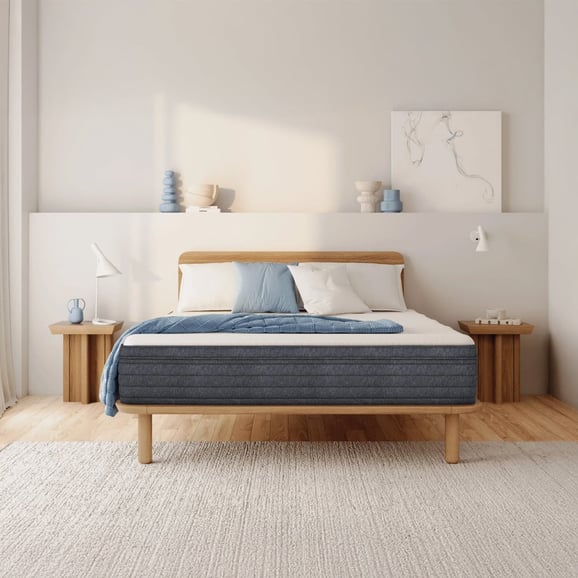Picture this: you’ve just invested in a brand new mattress. It’s plush, comfortable, and promises restful nights of sleep. But here’s the thing – mattresses don’t come cheap. So, wouldn’t it be great if you could make your mattress last longer and get the most out of your investment? Well, buckle up because I’ve got some tips to help you do just that.
We’ll also discuss the common factors that contribute to mattress wear and tear. By understanding these factors and implementing a few simple strategies, you can significantly prolong the life of your mattress and save yourself from shelling out money on a replacement too soon.
So, if you’re ready to embark on a journey towards maximising the lifespan of your beloved mattress, let’s get started!
Choose the Right Type of Mattress
Consider Individual Sleep Preferences and Needs
Choosing the right type of mattress is crucial. One size does not fit all. We all have different sleeping positions, body types, and comfort preferences. So, before you make a decision, take a moment to evaluate what you truly need for a comfortable sleep.
Evaluate Different Mattress Materials and Their Durability
There are various types of mattresses available in the market, each made from different materials. It’s important to understand the durability of these materials before making a purchase. Here are some common mattress materials:
Innerspring Mattresses: These mattresses contain coils that provide support and bounce. They tend to be more durable compared to other types.Memory Foam Mattresses: These mattresses conform to your body shape and relieve pressure points. While they offer excellent comfort, their lifespan can vary depending on the quality of foam used.Latex Mattresses: Made from natural or synthetic latex, these mattresses are known for their durability and resilience.Hybrid Mattresses: As the name suggests, hybrid mattresses combine different materials like memory foam, latex, or coils to offer a balance of comfort and support.
Seek Professional Guidance When Selecting a Suitable Mattress
Choosing the right mattress can be overwhelming with so many options available in the market. Seeking professional guidance can help you make an informed decision based on your specific needs and budget.
Visit a Local Bedding Store: Experts at bedding stores have extensive knowledge about different types of mattresses and can guide you through the selection process.Consult with a Sleep Specialist: If you have specific sleep issues or concerns, consulting with a sleep specialist or chiropractor can provide valuable insights into which type of mattress would best suit your needs.Read Online Reviews: Reading reviews from other customers who have purchased the same mattress can give you a better idea of its quality and durability.
Recommendations for Different Sleeper Types
Different types of sleepers have different requirements. Here are some recommendations based on sleeper types:
Side Sleepers: Look for a mattress that offers good pressure relief, especially around the shoulders and hips. Memory foam or hybrid mattresses with plush top layers can be a great choice.Back Sleepers: Opt for a medium-firm mattress that provides support to maintain proper spinal alignment.Stomach Sleepers: A firmer mattress is recommended to prevent sinking in too deeply, which can strain the back.
Remember, investing in a good quality mattress is an effective way to make it last longer. Take your time, explore different options, and consider your individual needs before making a decision.
Use a Mattress Protector
To make your mattress last longer, one of the best investments you can make is to use a mattress protector. This simple addition to your bedding not only shields your mattress from spills and stains but also helps protect against allergens like dust mites and bed bugs. Here’s why using a mattress protector is essential for extending the life of your mattress:
Shield your mattress from spills, stains, and allergens
Accidents happen, whether it’s a spilled drink or a pet accident. Without proper protection, these mishaps can seep into your mattress layers and cause permanent damage. A waterproof mattress protector acts as a barrier between the spills and your precious mattress, preventing any liquids from seeping through. By keeping moisture away from the inner layers of the mattress, you can prevent mould and mildew growth.
In addition to spills, a good quality mattress protector also safeguards against stains caused by sweat, body oils, or other bodily fluids. These substances can penetrate deep into the fabric of your mattress over time and create unpleasant odours. A protector prevents them from reaching the surface, making it easier to keep your bed clean and fresh.
Increase hygiene by preventing dust mites and bed bugs
Did you know that an unprotected mattress can become a breeding ground for dust mites? These microscopic creatures thrive in warm environments and feed on dead skin cells shed by humans. Not only do they trigger allergies in some individuals, but their waste products can also contribute to respiratory issues.
Bed bugs are another unwelcome visitor that can infest mattresses if given the chance. These blood-sucking pests are notoriously difficult to eliminate once they’ve taken up residence in your bedding.
A high-quality mattress protector acts as a barrier against both dust mites and bed bugs. Its tightly woven fabric prevents these pests from burrowing into the fibres of your mattress where they would otherwise multiply and wreak havoc on your sleep environment.
Extend the life of your mattress by reducing wear and tear
Over time, the constant use of a mattress can lead to wear and tear. Body weight, movement, and pressure exerted on the mattress can cause it to sag or develop lumps. However, using a mattress protector can help minimise these issues.
By providing an extra layer of protection, a mattress protector reduces direct contact between your body and the mattress surface. This helps distribute your weight more evenly and prevents excessive compression in specific areas.
Furthermore, a good-quality protector can also shield against dust particles that settle on the surface of your mattress over time. These particles can act like tiny abrasive agents, gradually wearing down the materials inside your bed.
Regularly Clean and Deodorise Your Mattress
To make your mattress last longer, it’s important to keep it clean and fresh. Regular cleaning not only helps remove dirt, dust, and debris but also eliminates germs and allergens that can accumulate over time. Here are some tips to help you effectively clean and deodorise your mattress:
Remove dirt, dust, and debris with regular vacuuming
One of the simplest ways to keep your mattress clean is by regularly vacuuming it. Use the upholstery attachment on your vacuum cleaner to gently remove any loose dirt, dust, or debris from the surface of the mattress. Pay extra attention to the seams and crevices where these particles tend to accumulate.
Pros:
Removes surface-level dirt and dust
Easy and quick cleaning method
Helps maintain a hygienic sleeping environment
Cons:
May not be effective for deep stains or odours
Requires a vacuum cleaner with an upholstery attachment
Utilise natural cleaning solutions for effective stain removal
If you notice any stains on your mattress, it’s essential to address them promptly. Using natural cleaning solutions can help effectively remove stains without damaging the fabric or materials of the mattress.
Create a mixture of dish soap and warm water.
Gently dab the stained area using a clean cloth soaked in this solution.
Blot the stain rather than rubbing it to avoid spreading it further.
Allow the area to dry completely before placing any bedding back on top.
Alternatively, you can use hydrogen peroxide mixed with baking soda for tougher stains like blood or urine.
Pros:
Gentle yet effective stain removal
Safe for most types of mattresses
Environmentally friendly option
Cons:
May not be suitable for all types of stains
Always perform a patch test before applying any cleaning solution extensively
Freshen up your mattress with baking soda or fabric sprays
Over time, mattresses can develop odours due to sweat, dead skin cells, and other factors. To keep your mattress smelling fresh, you can use baking soda or fabric sprays.
Sprinkle a thin layer of baking soda over the entire surface of the mattress.
Let it sit for a few hours to absorb any odours.
Vacuum the baking soda off the mattress using the upholstery attachment.
Alternatively, you can use fabric sprays specifically designed for mattresses. These sprays not only neutralise odours but also leave behind a pleasant scent.
Pros:
Absorbs and eliminates unpleasant odours
Easy and affordable solution
Gives your mattress a fresh and clean scent
Cons:
Baking soda may require several hours to be effective
Fabric sprays may contain artificial fragrances that some people may be sensitive to
Regularly cleaning and deodorising your mattress is essential for maintaining its longevity and ensuring a healthy sleeping environment. By following these tips and incorporating them into your regular maintenance routine, you can extend the lifespan of your mattress while enjoying a clean and fresh bed every night.
Rotate and Flip Your Mattress
To make your mattress last longer, it’s essential to evenly distribute body weight and ensure balanced use. One effective way to achieve this is by regularly rotating your mattress every few months. By rotating the mattress, you prevent excessive wear and tear on specific areas, such as the head or foot of the bed.
Rotating your mattress involves turning it around so that the side becomes the back and vice versa. This simple action helps to distribute pressure more evenly across the entire surface, preventing sagging in one particular spot. Manufacturers often recommend a 180-degree rotation for best results.
Flipping your mattress can also contribute to its extended durability, but this applies only if your mattress is double-sided. Double-sided mattresses have identical comfort layers on both sides, allowing you to flip them over periodically. Flipping not only evens out wear but also provides a fresh sleeping surface.
However, not all mattresses are designed to be flipped due to asymmetrical construction or built-in pillow tops. If your mattress falls into this category, you should focus solely on rotating it. Always refer to the manufacturer’s guidelines for specific instructions regarding flipping and rotating your mattress.
Evenly Distribute Body Weight to Prevent Sagging
Over time, our bodies tend to create impressions or “body indentations” in our mattresses due to repeated use in the same position night after night. To prevent these indentations from becoming permanent and causing sagging, it’s crucial to distribute body weight evenly across the entire surface of the mattress.
One way to achieve even weight distribution is by varying sleep positions throughout the night. For example, if you always sleep on one side of the bed near the edge, try alternating sides or moving toward the centre occasionally. This simple adjustment can help alleviate pressure on specific areas and promote even wear.
Using a high-quality supportive foundation or box spring can also aid in distributing body weight effectively. These bases provide additional support to the mattress, preventing excessive sinking and reducing the risk of sagging. Make sure to choose a foundation that is compatible with your mattress type for optimal performance.
Rotate the Mattress Every Few Months for Balanced Use
Rotating your mattress is an essential maintenance practice that helps ensure balanced use and prolong its lifespan. By rotating the mattress regularly, you prevent overuse of specific areas while giving other parts a chance to recover from constant pressure.
To rotate your mattress effectively, start by removing all bedding and accessories. Then, firmly grip one side of the mattress and carefully turn it 180 degrees so that what was once the head end becomes the foot end. Repeat this process every few months to achieve consistent rotation.
By rotating your mattress regularly, you can avoid premature wear in certain areas, such as where you typically sleep or sit on the bed. This simple step promotes even distribution of body weight and ensures that all parts of the mattress receive equal amounts of pressure over time.
Remember, each mattress has its unique characteristics and requirements. Consult your manufacturer’s guidelines or warranty information for specific recommendations tailored to your particular mattress model.
Invest in a Sturdy Bed Frame
To make your mattress last longer, it’s essential to invest in a sturdy bed frame. A good bed frame provides proper support, preventing premature sagging and ensuring that your mattress stays in good shape for a longer time. Here are some key points to consider when choosing a bed frame:
Provide proper support to avoid premature sagging
A sturdy bed frame is crucial for providing the necessary support to your mattress. It helps distribute the weight evenly, reducing strain on specific areas of the mattress. This prevents sagging and ensures that your body is well-supported while you sleep.
Choose a frame made of durable materials like metal or hardwood
When selecting a bed frame, opt for one made of durable materials such as metal or hardwood. These materials offer excellent stability and longevity, ensuring that your mattress remains in good condition for years to come. Avoid frames made of low-quality materials that may not withstand regular use.
Ensure compatibility between the frame size and your mattress
Another important factor to consider is the size compatibility between your bed frame and mattress . Make sure that the dimensions of both match perfectly. A mismatched size can lead to unnecessary stress on the edges or corners of the mattress, causing it to wear out faster.
Investing in a solid platform or slatted bed base can also provide additional support for your mattress. These options help prevent sagging by distributing weight evenly across the surface.
Taking good care of your bed frame is equally important. Avoid jumping on the bed excessively, especially if you have children who love bouncing around! Excessive force can damage both the frame and the mattress, leading to decreased durability over time.
Avoid Eating or Drinking in Bed
To ensure a healthy sleep environment and better sleep quality, it’s important to take care of your mattress. One effective way to prolong its lifespan is by avoiding eating or drinking in bed. This simple habit can prevent accidental spills that could potentially damage the mattress and minimise exposure to food particles that attract pests.
Prevent Accidental Spills
Eating or drinking in bed may seem like a cosy indulgence, but it can lead to accidents that harm your mattress. Picture this: you’re enjoying a late-night snack while binge-watching your favourite show, and suddenly, you accidentally knock over a glass of water or spill some soda on the bed. Not only does this create an unpleasant mess, but it can also seep into the mattress and cause mould or mildew growth. By refraining from eating or drinking in bed, you eliminate the risk of these accidents altogether.
Minimise Exposure to Food Particles
Apart from spills, eating in bed can also leave behind food crumbs and particles that attract pests like ants or even bed bugs. These unwelcome visitors can find their way into your mattress, leading to potential infestations that are not only inconvenient but also detrimental to your health. To maintain cleanliness and keep these pests at bay, it’s best to keep all eating activities outside of the bedroom.
Maintain Cleanliness
By keeping food-related activities out of bed, you contribute significantly to maintaining cleanliness in your sleep environment. Food stains are stubborn and can be challenging to remove from mattresses – they often leave unsightly marks and odours behind. Food residue may accumulate over time if not cleaned properly, leading to an unhygienic sleeping surface. By establishing a “no food in bed” rule for yourself and others sharing the space with you, you ensure that your mattress remains clean and fresh for longer periods.
Taking small steps like avoiding eating or drinking in bed can go a long way in extending the lifespan of your mattress. Not only do you prevent accidental spills and potential damage, but you also minimise exposure to food particles that attract pests. By maintaining cleanliness and keeping eating activities outside of bed, you create a healthier sleep environment for yourself.
Key Takeaways for Extending Your Mattress Lifespan
Congratulations on making it through the sections on how to make your mattress last longer! By following these tips, you’re well on your way to maximising the lifespan of your mattress and getting the most out of your investment. Remember, a well-maintained mattress not only ensures better sleep but also saves you money in the long run.
To recap, choosing the right type of mattress is crucial for durability and comfort. Using a mattress protector protects against spills and stains while maintaining hygiene. Regularly cleaning and deodorising your mattress keeps it fresh and free from allergens. Rotating and flipping your mattress helps distribute wear evenly, extending its life. Investing in a sturdy bed frame provides essential support, preventing sagging or damage. And finally, avoiding eating or drinking in bed prevents accidental spills that can lead to permanent stains.
Now that you have all these valuable insights, it’s time to put them into action! Follow these steps diligently to ensure that your mattress remains in top condition for as long as possible. Your future self will thank you for taking care of your sleep sanctuary!
FAQs
How often should I rotate my mattress?
It’s recommended to rotate your mattress every three months to prevent uneven wear. This simple task helps maintain the shape and support of your mattress over time.
Can I clean my mattress with household products?
Yes, you can clean your mattress using common household products such as baking soda or upholstery cleaner. However, always check the manufacturer’s instructions before applying any cleaning solutions.
Should I use a box spring with my mattress?
Using a box spring can provide additional support for certain types of mattresses, but it’s not always necessary. Check with the manufacturer or consult an expert to determine if a box spring is suitable for your specific mattress.
How long does a typical mattress last?
The lifespan of a mattress varies depending on factors such as quality, usage, and maintenance. On average, a good-quality mattress can last between 7 to 10 years with proper care.
Can I repair a sagging mattress?
In some cases, a sagging mattress can be temporarily improved by using additional support, such as plywood boards or mattress toppers . However, if the sagging is severe or persistent, it may be time to consider replacing your mattress for optimal comfort and support.
Sources
Deodorising a mattress guide – Sleep.com
How to clean your mattress – Sealy














